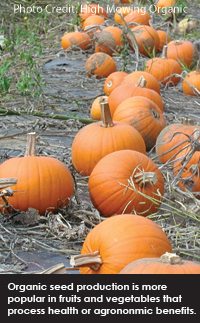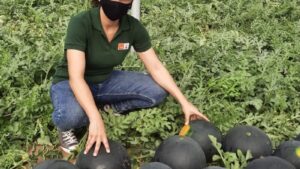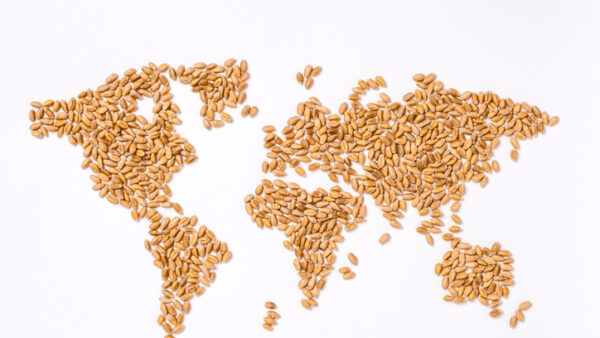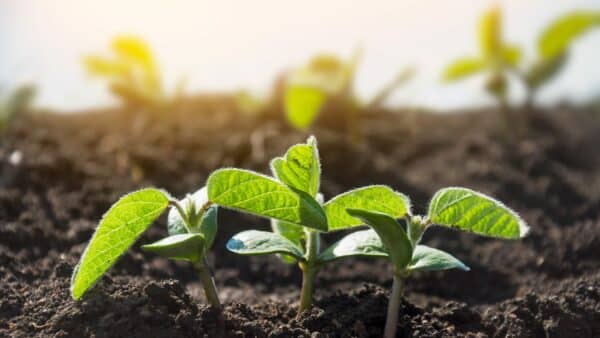Organic seed growers in the United States will potentially face some hard production decisions dependant on possible changes to certification regulations.
In order for organic fruit, vegetables and grain to be considered truly organically grown, do they have to grow from organic seed? Right now the answer to this question isn’t entirely clear, as the United States Department of Agriculture’s National Organic Program regulations allow certified organic growers to use non-organic (untreated, conventional) seed for their organic crops if they first make every effort to use organically grown seeds.
In a draft guidance issued by the NOP, section 205.204 states, “Certified operations may use non-organic seed and planting stock if organic seeds and planting stock are not commercially available in an appropriate form, quality or quantity to fulfill an essential function in organic production. Price cannot be a consideration.”
The sale of organic fruit and vegetables in the United States grew by 11 percent in 2009, commanding 38 percent of total organic food sales worth $26.6 billion. While organic food purchases came to less than four percent of the total U.S. food purchases in 2009, this market segment increased by 5.1 percent, compared to an increase of only 1.6 percent for all food purchases. There is no doubt that consumer demand for organic foods, especially produce, is increasing; this growth provides organic growers with good market potential, but this doesn’t completely equate to a higher demand for organic seed.
Organic Seed Not on Consumers’ Radar
When a shopper in the organic section of a Kansas City grocery store buys a bag of carrots, or even when they buy organic strawberries directly from the grower at a farmers’ market, they are unlikely to know or care whether or not the produce they’re buying is grown from organic seed.
Barb Perkins, owner of Vermont Valley Community Farm near Madison, Wis., provides about 1,300 boxes of organic produce to the farm’s 2,000 members each year. She says all her members know they are receiving organic produce, but none ask about the seed used to grow the fruit and vegetables in their boxes.
Even though consumers may not be knowledgeable about the use of organic seed, most organic growers wish to base their production on a holistic system that starts with organic seed. However, commercial growers aren’t currently able to buy organic seed for all the varieties they wish to grow.
Support Needed for Organic Seed
The Organic Seed Alliance, a research and education organization with a mission to support the ethical development and stewardship of the genetic resources of agricultural seed, recently released a report on its State of Organic Seed project. The report states, “Yet, even with the organic industry’s impressive growth, the organic seed sector has not caught up to meet this demand. There is a limited availability of appropriate organically produced seed for a variety of reasons, including cutbacks in public plant breeding programs, lack of investments from the private sector, seed industry consolidation, and ongoing disagreement regarding implementing NOP requirements pertaining to organic seed, among others.”
Vitalis Organic Seeds, a company within the Enza Zaden Group, was established in 1994 as the first U.S. seed company concentrating exclusively on breeding, producing, cleaning and selling high-quality seed for organic farmers. Erica Renaud, business development manager with Vitalis, agrees that there is a lack of government support for organic breeding. “There is not the same support for organic breeding in terms of infrastructure,” she says.
As with all plant breeding using traditional methods rather than genetic modification, it takes breeders years to develop a new variety, then collect enough seed so it can be grown in commercial production. In addition to the time involved in breeding new varieties, organic seed producers must abide by specific guidelines on organic growing methods. To make it worthwhile for a company like Vitalis to invest time and money to produce organic seed, there must be a pay-off. Renaud sees possible changes in NOP regulations, requiring organic growers to use an increasing percentage of organic seed each year, as being the catalyst the U.S. seed industry needs to encourage more organic seed development.
Tom Stearns, president of High Mowing Organic Seeds, agrees with Renaud’s assessment. “I am hoping the rules will change. I think that it will be very beneficial to the overall organic seed industry to have a seed rule that is clearer,” he says. “It will help stimulate the industry to grow, which is a great thing for everyone.”
Stearns founded his company, based in Hardwick, Vt., in 1996 when he grew and marketed 28 varieties on his own. Now High Mowing Seeds offers home gardeners and commercial growers about 500 heirloom, open-pollinated and hybrid varieties of vegetable, fruit, herb and flower seed. Stearns says about 80 percent of seed sales are made to commercial organic growers.
He is concerned that changes to the NOP regulations could result in increased paperwork for organic growers who don’t use organic seed because the varieties they wish to grow aren’t available as organic seed. “The important issue is in the balance—how is it implemented to serve growers rather than being a burden on them,” he says.
Barb Perkins and her husband, David, now use organic seed when they feel they can switch from conventional seed. “Every year we look at organic seed and see what is available. Does it have all the qualities we want?” she says.
Seed Must Offer Extra Benefits
The higher cost of organic seed isn’t a deterrent for most fruit and vegetable growers, according to Stearns, because organic growers are able to extract a premium for their produce. Perkins agrees, but adds they must be assured that organic seed holds additional benefits for them.
Mark Overduin, president of Bejo Seeds Inc. in Oceano, Calif., a subsidiary of Holland’s Bejo Zaden, knows that organic growers are looking for extra characteristics in organic seed. “We do expect to provide additional benefits such as broader adaptability, stronger overall immune systems, and more efficient root systems with stronger nutrient uptake capabilities,” he says.
The tipping point for organic seed—for seed growers and those organic producers who use it—could come from the development of organic seed that can grow fruit and vegetables possessing extra health benefits for consumers. For example, a new variety of red cabbage could contain a higher level of antioxidants, making it nutritionally superior to other varieties.
Stearns and Renaud say they welcome more competition in the organic seed market. “I see a huge opportunity, with 90 percent of the market now unfulfilled,” 
Whether the impetus for more organic seed production in the United States will com
e from changes to national organic certification regulations, stronger consumer demand for organic produce grown from organic seed, or additional agronomic benefits for producers using organic seed, the reality is that this industry is in its infancy, and will continue to grow up in the coming years. Andrea Geary
Rules for Organic Growers
The USDA’s National Organic program establishes the guidelines for certified organic crop production. According to a draft guidance issued in June 2011, organic growers can use non-organic seed to grow certified crops, but only if organic seed isn’t commercially available in an appropriate form, quality or quality
Reasons for using non-organic seed can include:
• Form considerations—site-specific agronomic or marketing characteristics, such as the number of days until maturity or harvest, color, flavor, weight or size of harvested crop, and disease and pest resistance. For example, a conventional seed variety might produce larger, healthier cucumbers than any organic seed variety now available.
• Quality considerations—germination rate of seed, presence of weed seeds in the seed mix, shelf-life and stability of seed, and disease and pest resistance.
• Quantity considerations—an insufficient amount of organic seed available for planting.
Organic growers must keep documents to prove to NOP certifying agents they have contacted a minimum of three seed sources to see if they are selling organic seed varieties that meet the growers’ needs.












